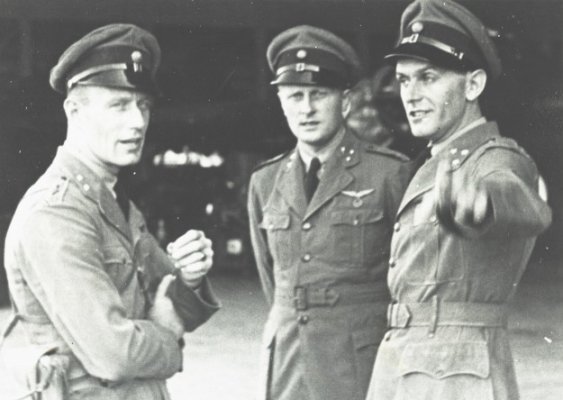
Photo Prints Royal Netherlands Air Force
Willem Frans Boot. Born 26 November 1906, Zuid-Beijerland. Died: 18 Januari 1987, Den Haag. He joined the Royal Netherlands Navy in 1934.
Even before the capitulation from Netherlands East Indies (NEI), staff of the Military Aviation Department of the KNIL(ML-KNIL) were sent to Australia.
Most of the department of Captain Willem Frans Boot went Brisbane to receive B-25 Mitchells from American overflight crews.
This involved an emergency allocation of 60 aircraft from current production for the U.S. Army Air Force. The largest group of personnel (43 men) left on 14 and 15 February 1942 for Archerfield airfield near Brisbane. This was the so-called detachment Boot. This detachment also included pilot Jan Lukkien who shortly before – on January 13, 1942 – at a dog fight with the Japanese at Balikpapan had been injured. The detachment left divided into four Lockheed Lodestars from Andirbee Bandung(two of the four Lodestars left a day later).
Boot’s assignment included taking over the first 14 Mitchells and flying these aircraft back to Java, where the department’s conversion would be completed. Initially, the detachment consisted of 18 pilots, 7 telegraphists and 14 mechanics. The new Mitchell bombers were already on their way when three aircrafts of Boot’s group arrived at Archerfield.
En-route from Cloncurry to Archerfield, the plane with Captain Boot onboard developed severe engine trouble on both engines and made an emergency landing in a meadow at Chinchilla Airport. The captain and four crew traveled by police car to Archerfield. The engines were repaired and a few days later the aircraft continued its flight to Archerfield.
For the transition at Archerfield it was thought that about a week per overflight crew would be needed. However, the ordered bombers were not delivered on time. Boot would later become the first commander of the 18 (NEI) Squadron RAAF.
At the end of February 1942, another detachment of the ML-KNIL left Java for Australia. This detachment, led by Major Roos, had the task of setting up a permanent organisation of the ML-KNIL in Australia for the training of personnel for the newly received aircraft. The first B-25 aircraft arrived on 2 March 1942, 6 days before the capitulation of the Dutch East Indies. The B-25 was an entirely new aircraft compared to the Glenn Martin that the ML-KNIL had flown until then. The rapid termination of the battle forced Boot to remain in Brisbane.
It was the intention of the commander of the ML-KNIL Van Oyen to make Boot squadron commander for the time being until the whole had reached operational strength. As the busy Archerfield airfield was not suitable for the training flights of the Dutch crews, the squadron was transferred to Canberra. The detachment was supplemented by personnel from the Depot Aircraft Department of the ML-KNIL, which had largely fled to Australia with Lockheed 12 aircraft and Lodestars.
It soon became clear that the Dutch were fighting a losing battle in NEI and another ML-KNIL detachment departed from Java for Australia. This detachment, led by Major Roos, was tasked with facing that reality by setting up a permanent ML-KNIL organisation in Australia for the operation of the aircraft.
In April 1942 the DVA was relocated to Canberra where it became the No. 18 (NEI) Squadron, which was part of the Royal Australian Air Force (RAAF). However, the appointment of Captain Boot as squadron commander was met with discontent among his troops, who were resistant to having him in charge. The unpopularity of Boot among his men contributed to his lack of success in the role.
As a result, on June 1, 1942, Major B.J. Fiedeldij was proposed as the replacement for Captain Boot, and Fiedeldij took over as the new commander of No. 18 (NEI) Squadron.
After his stint as squadron commander, Captain W.F. Boot was reassigned as a liaison officer at Allied headquarters, assuming the position previously held by Major Coppens. His role was to facilitate communication and coordination between different units and headquarters.
It is worth noting that Captain H.J. de Vries, from the Dutch Army, also served as a liaison officer, but at the Commander-in-Chief Armed Forces East and at the headquarters of the Allied Air Force.
Despite his initial difficulties as a squadron commander, on February 14, 1946, pilot captain W.F. Boat became squadron commander for the second time. He would remain commander until June 29, 1946. On August 11, 1944, a sunset attack on Langgoer airfield was made by twelve aircraft, including the N5-178 flown by Lieutenant Colonel D.L. Asjes and copilot captain W.F. Boot. On September 9, 1944, a special mission flown by Captain W.F. Boat (N5-173), place. The aim was to dump food and medicines at Seroea, Damar, Te-oen and the Nila Islands for the hard-hit population in those areas.
During his service with No. 18 (NEI) Squadron in the Pacific, he completed 30 missions, accumulating a total flight time of 321 hours. In recognition of his contributions, Captain W.F. Boot was awarded the Pilot’s Cross.
